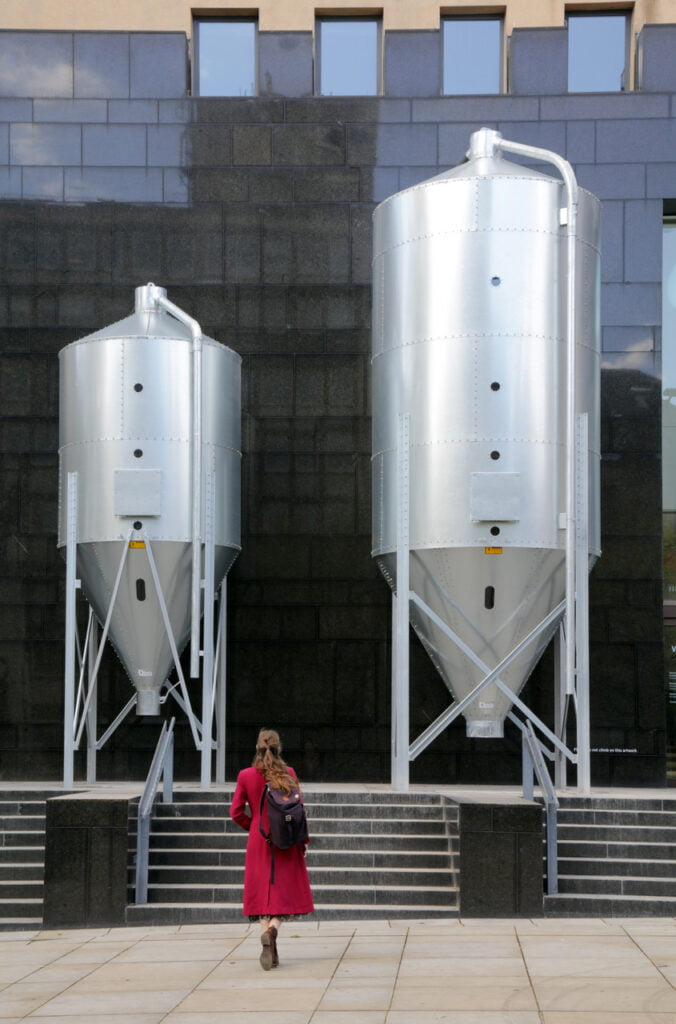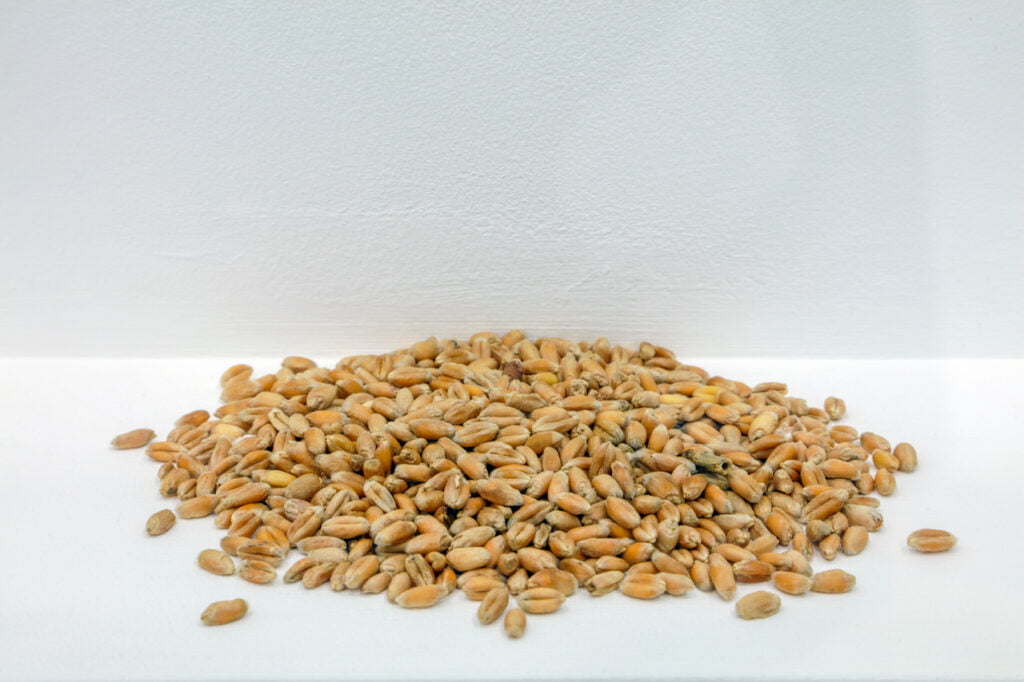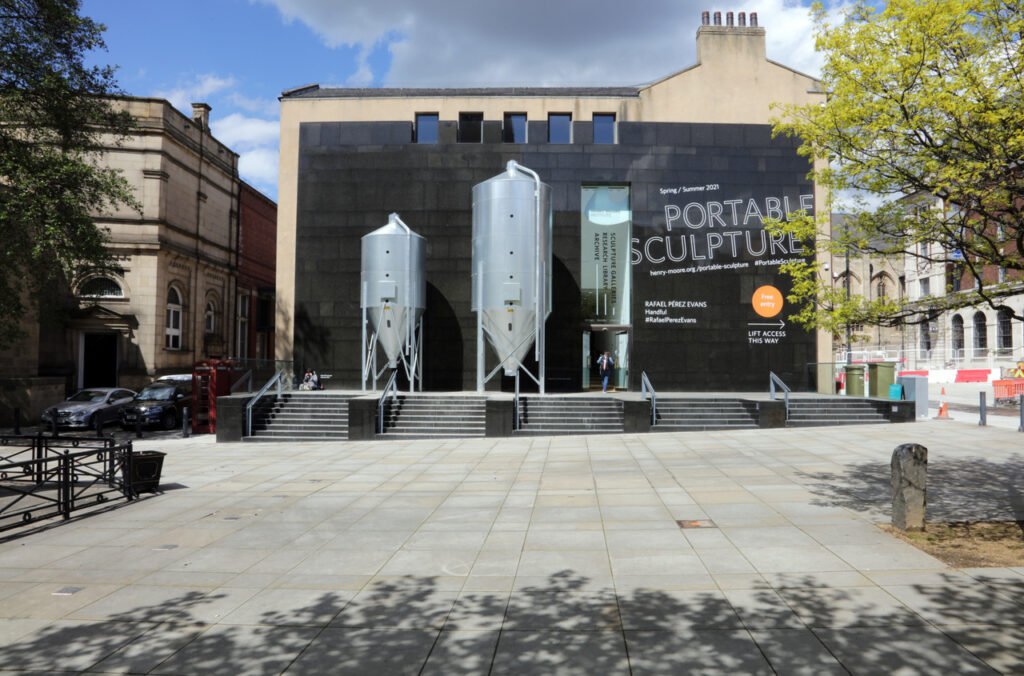
Photo by Jerry Hardman-Jones, courtesy of the Henry Moore Institute
Rafael Pérez Evans’ new exhibition at Leeds’s Henry Moore Institute seeks to reacquaint us with the processes which enable us to quickly, cheaply and easily obtain food. Although only a small exhibition consisting of just three pieces, Pérez Evans’ new work seeks to show us the scale of what is involved in food production and farming, reorienting how we view the food we eat, and in turn stopping it being taken for granted. Perhaps the most attention grabbing of these works is ‘Mountain’, a piece which consists of two large grain silos situated in front of the gallery.
Pérez Evans gained widespread media attention for his work ‘Grounding’ in which he dumped 31 tons of carrots which had been deemed unfit for consumption, outside a Goldsmith’s University building. This was a homage to a form of protest used by many European farmers, wherein large amounts of food would be dumped outside government buildings as a way of protesting falling prices in produce. Although Pérez Evans’ previous work can arguably be seen as wasteful, a concerted effort has been made in this exhibition to minimise food waste, whilst still using it as a medium to further his message.
One piece we can see this in is ‘Handful’. The work consists of a small pile of grain on a white shelf, the amount needed to sustain one human being. This piece in particular seems to have been created with an awareness of his previous work, and could in many ways be seen as a direct response to ‘grounding’. Where one shows excess, and the amount of food that is wasted on a daily basis, the other shows the exact amount a person needs. Looked at side by side, we gain a sense of scale on how much food is produced and how much one person requires.

Photo by Jerry Hardman-Jones, courtesy of the Henry Moore Institute
The pairing of ‘Handful’ with the giant grain silos outside the gallery also gives a sense of scale to industrial farming and agriculture. In ‘Handful’, we are presented with one small constituent part of what fills the huge void inside the grain silos. By placing the two together, with ‘Mountain’ on the outside of the gallery and ‘Handful’ on the inside, we are able to understand how many people’s food the silos would account for. On entering the gallery, the silos’ scale seems vast and immeasurable. On exiting, however, having seen the amount of grain present in ‘Handful’, the use and value of the silos becomes quantifiable. The two pieces allow us to see both the huge amounts of food which are produced each day, and also the value of such a small amount of it. The two realisations work in tandem, and produce a huge feeling of respect for the process of food production.
The piece also highlights our disconnectedness with food production through its placement in a city centre. It is a bizarre feeling to encounter something so heavily associated with rural life whilst walking through a city. The silos look alien and out of place in the otherwise urban environment. This strangeness is added to by the knowledge that such structures are commonplace in rural areas where farming is an everyday part of life. This again highlights the distance between how we think of food, and the reality of its having been brought to our shops. The silos should not be a new and out of place sight, but something we are familiar with and aware of. They are an everyday part of our lives in that we rely on them for food, yet the sight of them, to many of us, is jarring and unusual.
The unfamiliarity of the silos in ‘Mountain’ is also perhaps what makes them so intriguing. On a purely visual level, they resemble space ships from an early sci-fi film; stood upright in gleaming metallic silver with pointed tops and cartoonish glass portholes. Just as the piece highlights disconnectedness between the urban and rural, it also shows striking similarities between the past and imagined or even real futures. Here, the learning potential for children that the silos offer becomes apparent. It is easy to see how a child could walk past and be drawn to the futuristic looking objects, asking their parents about them and leaving with the new knowledge about where food comes from and how it is made available.

Photo by Jerry Hardman-Jones, courtesy of the Henry Moore Institute
The piece’s treatment of grain silos as art also raises interesting questions. By taking something industrial and fit for purpose, and placing it as a piece of art, Pérez Evans makes us question the boundaries of what we can actually classify as art. The piece also raises interesting comparisons with the piece which preceded it outside the Henry Moore Institute: Paloma Varga Weisz’s ‘Bumped Body’ exhibition, depicting a human figure covered in tennis ball sized lumps. The installation, although arguably more initially shocking, perhaps adheres more closely to what the general public may think of as art. By following this with ‘Mountain’, the Henry Moore institute have gone to the opposite end of the spectrum in sculpture, demonstrating new forms of art to those unfamiliar with them, and asking people to question what, in fact, should be seen as art.
The exhibition notes and gallery website discuss how Pérez Evans’ aim has been to try and make people re-think where their food comes from and what goes into making it appear on shelves. The exhibition achieves this by not only giving an insight into the scale of industry, and highlighting our disconnectedness to it, but also by raising awareness of the means used to supply food. This is the crux of why Pérez Evans’ work is successful: by gaining knowledge about where food comes from, we gain respect for it.
Filed under: Art & Photography
Tagged with: agriculture, art, artist, contemporary, exhibition, food, Henry Moore Institute, industry, production, Rafael Pérez Evans’, shortage



Comments